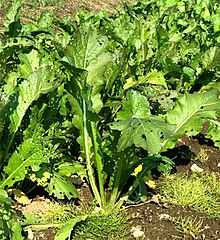Nozawana: Difference between revisions
Appearance
Content deleted Content added
Tom.Reding (talk | contribs) m +{{Taxonbar|from=Q3049961}} (0 sig. taxon IDs: 1-time run thru Category:Taxobox articles missing a taxonbar; WP:GenFixes on |
No edit summary |
||
| Line 1: | Line 1: | ||
{{short description|Japanese leaf vegetable, often pickled}} |
{{short description|Japanese leaf vegetable, often pickled}} |
||
{{Unreferenced|date=June 2008}} |
|||
{{Taxobox |
{{Taxobox |
||
|name = Nozawana |
|name = Nozawana |
||
| Line 17: | Line 16: | ||
}} |
}} |
||
[[File:Mentaiko bento.jpg|thumb|[[Mentaiko]] and nozawana on rice]] |
[[File:Mentaiko bento.jpg|thumb|[[Mentaiko]] and nozawana on rice]] |
||
'''Nozawana''' (野沢菜, ''Brassica rapa'' L. var. ''hakabura'') is a [[Japan]]ese [[leaf vegetable]], often [[Pickling|pickled]]. It is of the same [[species]] as the [[turnip|common turnip]] and one of a Japanese variety of [[Mustard plant|mustard]] leaf. Its leaves are approximately 60–90 cm long. |
'''Nozawana''' (野沢菜, ''Brassica rapa'' L. var. ''hakabura'') is a [[Japan]]ese [[leaf vegetable]], often [[Pickling|pickled]].<ref>{{Cite web|url=https://www.nozawaholidays.com/news/nozawana-perfect-pickle-nozawa-onsen/|title=Nozawana - the perfect pickle in Nozawa Onsen|date=2016-08-16|website=Nozawa Holidays|language=en-AU|access-date=2019-06-25}}</ref> It is of the same [[species]] as the [[turnip|common turnip]] and one of a Japanese variety of [[Mustard plant|mustard]] leaf.<ref>{{Cite web|url=https://asianinspirations.com.au/recipes/pickled-mustard-leaves-nozawana-zuke/|title=Pickled Mustard Leaves (Nozawana-zuke)|date=2017-07-17|website=Asian Inspirations|language=en-AU|access-date=2019-06-25}}</ref> Its leaves are approximately 60–90 cm long. |
||
Sometime between 1751-1764 it was taken by the master of a [[Buddhist temple]] who lived in [[Nozawaonsen, Nagano|Nozawa]] in the [[Kyoto Prefecture|Kyoto]] mountains to the Nozawa-[[onsen]] village. It was cultivated around that area, and thus named Nozawana: ''na'' means vegetable in [[Japanese language|Japanese]]. |
Sometime between 1751-1764 it was taken by the master of a [[Buddhist temple]] who lived in [[Nozawaonsen, Nagano|Nozawa]] in the [[Kyoto Prefecture|Kyoto]] mountains to the Nozawa-[[onsen]] village. It was cultivated around that area, and thus named Nozawana: ''na'' means vegetable in [[Japanese language|Japanese]]. |
||
Pickled nozawana is one of the most typical local foods in [[Nagano Prefecture]]. It is also used in [[onigiri]]. |
Pickled nozawana is one of the most typical local foods in [[Nagano Prefecture]]. It is also used in [[onigiri]].<ref>{{Cite web|url=https://asianinspirations.com.au/recipes/japanese-savoury-buns-nozawana-oyaki/|title=Japanese Savoury Buns (Nozawana Oyaki)|date=2017-07-17|website=Asian Inspirations|language=en-AU|access-date=2019-06-25}}</ref> |
||
== References == |
|||
{{Taxonbar|from=Q3049961}} |
<references />{{Taxonbar|from=Q3049961}} |
||
[[Category:Leaf vegetables]] |
[[Category:Leaf vegetables]] |
||
Revision as of 22:49, 25 June 2019
| Nozawana | |
|---|---|

| |
| Nozawana | |
| Scientific classification | |
| Kingdom: | |
| Phylum: | |
| Class: | |
| Order: | |
| Family: | |
| Genus: | |
| Species: | rapa (syn B. campestris)
|
| Variety: | var. hakabura
|
| Binomial name | |
| Brassica rapa L. var. hakabura | |

Nozawana (野沢菜, Brassica rapa L. var. hakabura) is a Japanese leaf vegetable, often pickled.[1] It is of the same species as the common turnip and one of a Japanese variety of mustard leaf.[2] Its leaves are approximately 60–90 cm long.
Sometime between 1751-1764 it was taken by the master of a Buddhist temple who lived in Nozawa in the Kyoto mountains to the Nozawa-onsen village. It was cultivated around that area, and thus named Nozawana: na means vegetable in Japanese.
Pickled nozawana is one of the most typical local foods in Nagano Prefecture. It is also used in onigiri.[3]
References
- ^ "Nozawana - the perfect pickle in Nozawa Onsen". Nozawa Holidays. 2016-08-16. Retrieved 2019-06-25.
- ^ "Pickled Mustard Leaves (Nozawana-zuke)". Asian Inspirations. 2017-07-17. Retrieved 2019-06-25.
- ^ "Japanese Savoury Buns (Nozawana Oyaki)". Asian Inspirations. 2017-07-17. Retrieved 2019-06-25.
